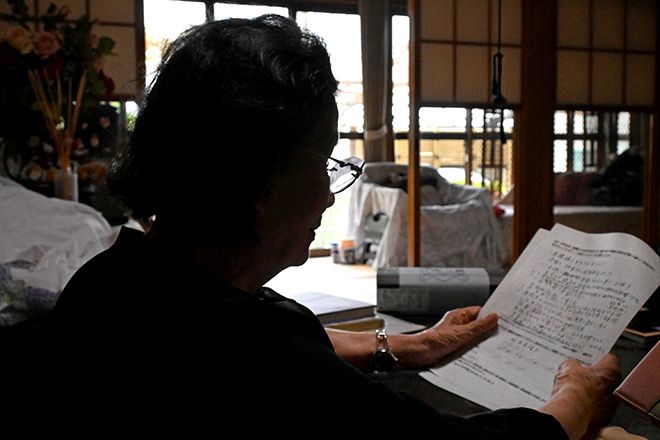94-Year-Old Seizes Chance to Tell Her Story of Atomic Bombing
TMS PEACE JOURNALISM, 25 Aug 2025
Akari Uozumi | The Asahi Shimbun - TRANSCEND Media Service
TAS Editor’s note: This is part of a series on hibakusha who responded to a survey by The Asahi Shimbun, The Chugoku Shimbun and The Nagasaki Shimbun on the 80th anniversary of the atomic bombings.

Michiko Sakamoto looks over the survey at her home in Kodaira, Tokyo. Her family opposed publishing a photo showing her face, fearing harassment on social media. (Akari Uozumi)
1 Aug 2025 – When Michiko Sakamoto opened the questionnaire sent to atomic bomb survivors nationwide, ideas for what she wanted to write came in a rush.
The 94-year-old sat at her “kotatsu” heated table and gripped a pen at her home in the western Tokyo city of Kodaira.
She wrote, “I was taunted as an ‘atomic bomb girl’ and tormented.” Marriage also weighed heavily on her. “I was rejected for marriage, which delayed my chance to wed.”
Elsewhere, she jotted down: “My husband’s family refused to allow me to bear children, fearing an adverse effect on future generations.”
For most of her life, Sakamoto was wounded by jaundiced stares and heartless remarks from those around her.
Until this year, she had refused to share her experiences, thinking, “If I put them into words, it feels like they are not such a big deal.”
But she had a change of heart this year, which marks 80 years since that fateful day.
Sakamoto was 14 years old when an atomic bomb devastated her city, Nagasaki, on Aug. 9, 1945.
A third-year student at Nagasaki Prefectural Nagasaki Girls’ High School, she was making torpedoes at a Mitsubishi Heavy Industries Ltd. factory, where students were mobilized.
Shockwaves from the blast caused a wooden sign hanging from the factory ceiling to fall on her. Trapped underneath, she lost consciousness. When she came to, flames were raging.
She crawled out of the rubble and headed home, using railway tracks as a guide. Sakamoto kept running over burning rail ties and had to repeatedly dip her rubber shoes into puddles to cool them. There were bodies lying everywhere and she eventually became numb to the sight.
When she finally reached her home, Sakamoto found it had been flattened by the blast. But she found her family safe, causing her to shed tears for the first time that day.
Sakamoto became an elementary school teacher after the war. She married at 28 and moved to Tokyo because of her husband’s work. Her relationship with her mother-in-law, who had opposed the marriage to a hibakusha until the very end, never stopped being strained.
ONLY DARK MEMORIES
While her memories associated with the atomic bomb were all grim, Sakamoto felt the weight of them lift when she tried to put them into words.
That was why she had never spoken about her experiences. But now, more than 90 years old, she felt this might be her last chance to tell her story.
Sakamoto filled the survey form with whatever came to mind, without following chronological order.
“I know I should write more systematically,” she said. “But since this is my first time, I just jotted things down as they came back to me, thinking, ‘I have to write this, too, and that, too.’”
Sakamoto wrote about how her hair almost completely fell out after the bombing, forcing her to wear a black hat to school.
She also wrote about nursing her aunt, who resembled a “nopperabo” faceless ghost because her face was burned charcoal black and featureless.
Everything came pouring out once she started writing.
________________________________________________
Akari Uozumi is a staff writer at The Asahi Shimbun.
Tags: Atomic Weapons, Hibakusha, Hiroshima and Nagasaki, Japan, Nuclear Weapons, USA, WWII
DISCLAIMER: The statements, views and opinions expressed in pieces republished here are solely those of the authors and do not necessarily represent those of TMS. In accordance with title 17 U.S.C. section 107, this material is distributed without profit to those who have expressed a prior interest in receiving the included information for research and educational purposes. TMS has no affiliation whatsoever with the originator of this article nor is TMS endorsed or sponsored by the originator. “GO TO ORIGINAL” links are provided as a convenience to our readers and allow for verification of authenticity. However, as originating pages are often updated by their originating host sites, the versions posted may not match the versions our readers view when clicking the “GO TO ORIGINAL” links. This site contains copyrighted material the use of which has not always been specifically authorized by the copyright owner. We are making such material available in our efforts to advance understanding of environmental, political, human rights, economic, democracy, scientific, and social justice issues, etc. We believe this constitutes a ‘fair use’ of any such copyrighted material as provided for in section 107 of the US Copyright Law. In accordance with Title 17 U.S.C. Section 107, the material on this site is distributed without profit to those who have expressed a prior interest in receiving the included information for research and educational purposes. For more information go to: http://www.law.cornell.edu/uscode/17/107.shtml. If you wish to use copyrighted material from this site for purposes of your own that go beyond ‘fair use’, you must obtain permission from the copyright owner.
Join the discussion!
We welcome debate and dissent, but personal — ad hominem — attacks (on authors, other users or any individual), abuse and defamatory language will not be tolerated. Nor will we tolerate attempts to deliberately disrupt discussions. We aim to maintain an inviting space to focus on intelligent interactions and debates.
Read more
Click here to go to the current weekly digest or pick another article:
TMS PEACE JOURNALISM: